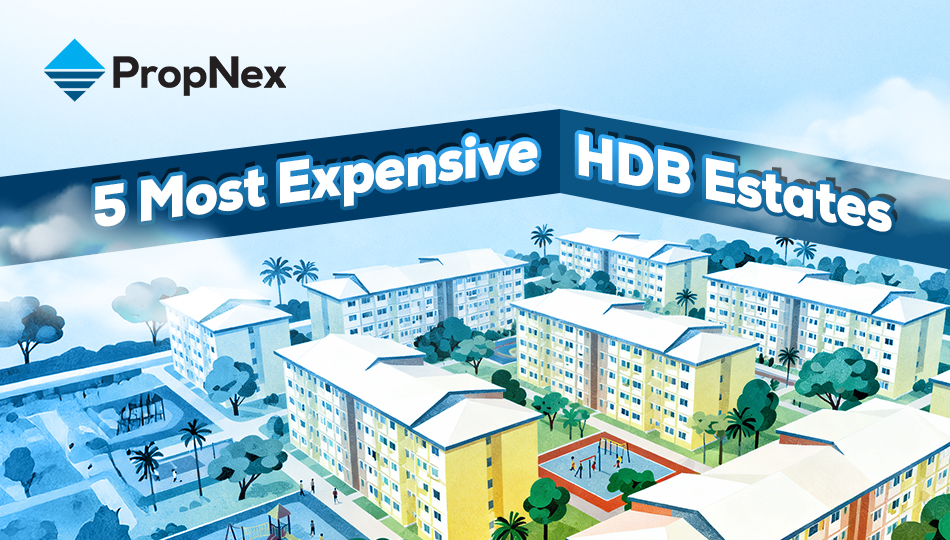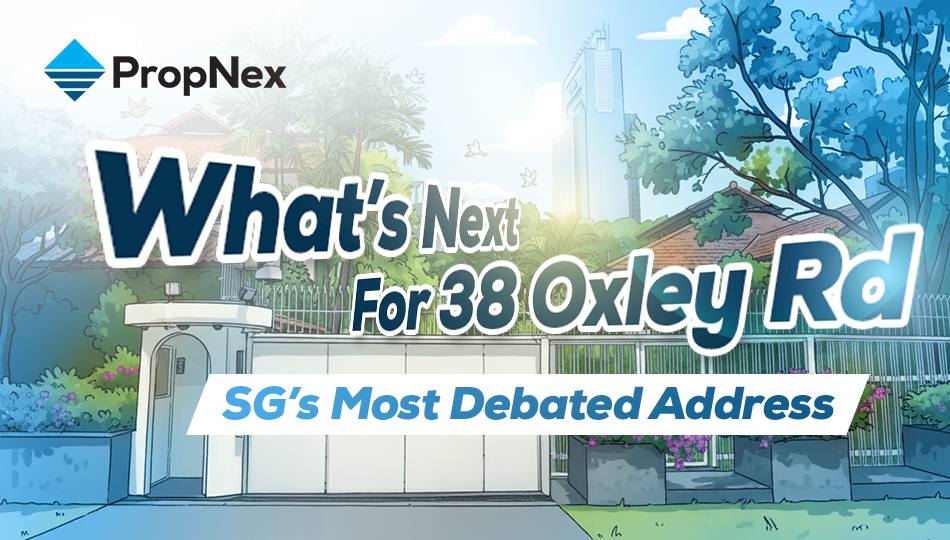What Puts the 'Good' in Good Class Bungalows?

When it comes to luxury living in Singapore, few properties hold as much allure as Good Class Bungalows (GCBs). These sprawling homes are the envy of the city, known for their vast landscapes, quiet elegance, and exclusivity that goes beyond a hefty price tag. But what truly makes a GCB, well... "good"? Let us dive into the charm, exclusivity, and mystique that define Singapore's ultimate real estate status symbol.
The term "Good Class Bungalow" is not just a fancy way of saying "EXTREMELY BIG HOUSE" - they are symbols of Singapore's heritage, luxury, and exclusivity. The term is a uniquely Singaporean designation, created by URA, for large, prestigious properties that meet specific criteria.
The historical context: Where did GCBs come from?
GCBs first gained prominence during Singapore's colonial period. At that time, sprawling bungalows housed high-ranking British officials, wealthy merchants, and influential local figures, representing a form of residential luxury that was unparalleled.
After independence, Singapore began regulating these bungalows, preserving them as a distinct and exclusive part of the real estate market. Over the decades, GCBS evolved from being colonial relics to Singapore's most coveted luxury homes, cementing their status as highly prized investments.

Specific characteristics that define a GCB
Unlike other types of properties, GCBs must meet precise criteria to earn the "Good Class" label:
Minimum plot size: To qualify as a GCB, the property must have a minimum land area of 1,400 square metres (approximately 15,000 square feet). The house itself must not occupy more than 40% of the total land plot. This vast size ensures ample space for outdoor living, allowing owners to build extensive gardens, large swimming pools, or even private sports courts.
"Is it just me, or does a GCB have enough space to get lost in? Like, what do they even do with all that room-host weekly marathons?"
Architectural guidelines: GCBs must adhere to architectural restrictions to ensure they harmonise with their surroundings. In order to maintain the open, low-density feel of the neighbourhood, GCBs can only have a maximum height of 12 metres (no taller than two stories). There also has to be an adequate amount of greenery.
Exclusive locations: GCBs can only be located in one of the 39 designated GCB zones in Singapore. These zones are concentrated in the most prestigious and desirable areas (Districts 10, 11, 20, 21, and 23), such as Bukit Timah, Holland Road, and Nassim Road, and generally are low population density and freehold lands.
Source: Business Times
Why the GCB designation matters
The "Good Class" label is not just about size or appearance - it is about preserving a way of life. GCBs are designed to create a sense of serenity in the midst of Singapore's bustling cityscape. Unlike condos or HDBs, GCBs provide homeowners with expansive, private spaces rarely found in Singapore. These properties offer a sense of seclusion and tranquillity, as they are strategically placed away from the hustle and bustle.
For instance, Nassim Road is known for housing some of Singapore's most valuable GCBs, with expansive homes that blend into the natural surroundings. A recent Nassim Road GCB broke records, marketing for over $300 million - illustrating the astronomical value and appeal that come with the "Good Class" label.
Source: The Business Times
The scarcity factor
With only about 2,800 GCBs in existence and strict regulations on new ones, GCBs are extraordinarily rare. They occupy a mere fraction of Singapore's residential landscape, making them highly desirable for wealthy Singapore citizens and long-term investors. This scarcity factor not only increases the prestige of owning a GCB but also enhances its value over time, as supply remains limited while demand continues to grow.
According to URA, GCBs have consistently appreciated in value over the years, often maintaining or increasing their worth even during economic downturns, as compared to other property types. In the last five years alone, GCB prices have climbed by an average of 30%, underscoring their role as resilient investments. For that, ultra-high-net-worth individuals are particularly drawn to them. For investors, GCBs offer a unique combination of exclusivity, security, and long-term value, making them a prime asset in any real estate portfolio.
In essence, GCBs represent more than just a large home - they are a way of life, a historical legacy, and a carefully curated slice of luxury in Singapore. With unparalleled exclusivity and storied charm, GCBs truly embody what it means to be "good" - and then some.
One of the defining aspects of GCBs is its location. Unlike other properties scattered across Singapore, GCBs are concentrated in 39 exclusive zones, handpicked for their historical and cultural significance as well as their aesthetic appeal. These areas are known for their low-density layouts, natural beauty, and proximity to upscale amenities.
Why these areas are so desirable:
Proximity to nature: GCB zones are often situated near lush green spaces, such as Singapore Botanic Gardens or Bukit Timah Nature Reserve, offering residents peaceful surroundings and easy access to nature. In fact, if you drive or walk around the zones, you will find many protected state trees, also known as the National Parks Board's Tree Conservation Areas.
Centrality: Most GCB neighbourhoods are centrally located, providing easy access to key parts of the city without sacrificing privacy.
Historical prestige: Many GCB neighbourhoods have a rich heritage, with roots tracing back to Singapore's colonial period. Living in these areas is like owning a piece of history. These areas were gazetted to preserve the high environmental quality of these established large bungalow areas by preventing the encroachment of more dense housing types, such as terrace or semi-detached houses.
According to Investment Suite, the average price per square foot in these GCB neighbourhoods range from $2,500 to over $4,000, underscoring the premium attached to these locations.
GCBs are not only defined by their location and size but also by their unique design standards, which emphasise elegance, harmony with nature, and understated luxury. These homes must follow guidelines that promote a cohesive look throughout the neighbourhood, ensuring that the "Good Class" aesthetic remains intact.
For starters, GCBs must be minimally 1,400 square metres. This is to prevent the plot from being used to develop more housings. So, unless the plot of land is at least 2,800 square metres, you cannot build two GCBs. GCBs are also restricted to 12 metres, approximately two floors, maintaining the low-density character of these neighbourhoods. This rule allows for an open airy feel, ensuring that the surrounding neighbourhood skyline remains unobstructed.
Just like how authorities have conserved shophouses, another type of rare luxury properties, out of the 2,800 GCBs, approximately 65 of them have been marked for conservation, which means the buyer cannot tear those down and rebuild. Chances are if the GCB you are looking at comes with colonial architecture, it has been marked for conservation.
Other than that, the specific architectural style of each GCB varies depending on the requirements and preferences of the homeowner. Some GCBs even have expansive outdoor areas, such as sprawling gardens, patios, and pools that transform the property into a private sanctuary. These unique touches enhance the value and character of the homes, making each GCB distinctive.
Owning a GCB in Singapore is akin to holding a prestigious badge of honour. Just like how you might associate luxury branded or limited edition goods from top brands, such as Louis Vuitton and Hermes, priced significantly more than their actual value, the same can be said of GCBs. The actual value is the prestige and status of owning such an exclusive property alongside other benefits, such as greenery and spaciousness.
With Singapore's stringent ownership restriction, ONLY Singapore Citizens can buy GCBs, adding a layer of exclusivity. Foreigners, including Permanent Residents, must first seek approval from SLA to buy a GCB. This distinction makes GCBs a highly sought-after status symbol, especially among the affluent and influential.
Social status: In Singapore, owning a GCB is more than just a financial investment - it is a social statement. It is a mark of success that places homeowners among an elite circle, a group that includes ultra-high-profile business leaders and notable public figures, such as James Sheng (Alibaba co-founder), Zhang Yong (HaiDiLao owner), and Jet Li (kung-fu star). Yep! These public figures are now fellow Singaporeans!
Legacy: For many, a GCB is a legacy purchase, passed down through generations. It is common for GCBs to remain within families for decades, serving as cherished family homes and valuable assets.
The exclusivity of GCBs is carefully crafted through regulations that restrict their ownership to Singapore Citizens. This rule not only maintains the cultural and historical value of GCBs but also preserves their status as a truly Singaporean luxury.
The appeal of limited access:
Regulated buyer pool: By limiting ownership to Singapore Citizens, GCBs remain primarily in local hands, reinforcing their identity as a national treasure and adding to their scarcity. That being said, there are two key factors that are considered when assessing foreigners looking into buying a GCB - a) The applicant's status as a Singapore PR for at least 5 years, b) The applicant's record of notable economic contributions to Singapore during this time.
High demand, limited supply: With only about 2,800 GCBs in the entire country, demand consistently outstrips supply. This imbalance drives their value upward, making them one of the most resilient real estate assets in Singapore.
As Singapore's real estate landscape continues to evolve and land becomes increasingly scarce, GCBs face a future shaped by both opportunities and challenges. Despite the ever-growing demand for land, their prestige, rarity, and distinctive character suggest they will remain an essential part of Singapore real estate landscape. Let us explore some possible factors that may influence their future.
Growing rarity and rising value
The number of GCBs will not grow. As our nation's population increases and urban development intensifies, the pressure to utilise every available plot of land increases, making GCBs even scarcer and, therefore, more valuable. In the future, this scarcity will likely drive their prices higher, transforming these homes into even more power status symbols and ultra-premium investments.
Challenges from urbanisation and population density
As urbanisation intensifies, GCBs may face some pressures due to their large land footprint. The Singapore government may face difficult decisions about balancing urban density with preserving heritage-rich estates. While it is unlikely that existing GCBs will be reclassified or redeveloped due to strict regulations, future development (similar in size or exclusivity) could be restricted, further heightening their appeal and rarity. Given the increasing demand for housing, authorities may also implement policies to maximise land efficiency in other areas, keeping GCB zones as low-density regions but with heightened environmental standards.
In summary, the future of GCBs is marked by both continuity and change. These homes are likely to grow even more valuable as they become increasingly rare, embodying a blend of heritage and sustainability. With a legacy rooted in exclusivity and prestige, GCBs will continue to serve as a hallmark of ultra luxury and cultural heritage in Singapore, adapting to new trends while preserving their timeless appeal.
So, what truly puts the "good" in Good Class Bungalows? It is a mix of history, exclusivity, and an aura that is hard to replicate. In a fast-paced city, these homes offer a sense of tranquillity and prestige that is unmatched. Whether as a residence or an investment, owning a GCB is like holding a VIP pass to Singapore's elite lifestyle.
If you have ever dreamed of living in a sanctuary, a GCB might just be the pinnacle of that vision. After all, in Singapore, there is good - and then there is Good Class.
Views expressed in this article belong to the writer(s) and do not reflect PropNex's position. No part of this content may be reproduced, distributed, transmitted, displayed, published, or broadcast in any form or by any means without the prior written consent of PropNex.
For permission to use, reproduce, or distribute any content, please contact the Corporate Communications department. PropNex reserves the right to modify or update this disclaimer at any time without prior notice.














